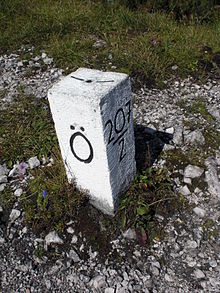- Ö
-
Ö ö "Ö", or "ö", is a character used in several extended Latin alphabets, or the letter O with umlaut to denote the front vowels [ø] or [œ]. In languages without umlaut, the character is also used as a "O with diaeresis" to denote a syllable break, wherein its pronunciation remains an unmodified [o].
Contents
O-Umlaut
The letter O with umlaut appears in the German, Swedish, and Icelandic alphabets. It represents the umlauted form of o, resulting in [œ] or [ø]. The letter is collated together with O in the German alphabet, but located in the end of the Swedish and Icelandic ones. The letter also occurs in some languages that have adopted German names or spellings, but is not normally a part of these alphabets.
In other languages that do not have the letter as part of the regular alphabet or in limited character sets such as ASCII, O-umlaut is frequently replaced with the digraph "oe".
Letter Ö in other languages
The letter Ö occurs, apart from Germanic languages, in the Uralic languages Finnish, Karelian, Estonian, Southern Sami, and Hungarian, in the Turkic languages such as Azeri, Turkish, Turkmen, Uyghur (Latin script), Crimean Tatar, and in the Uto-Aztecan language Hopi, where it represents the vowel sounds [ø, œ]. Its name in Finnish, Swedish, Icelandic, Estonian, Azeri, Turkish, Turkmen, Uyghur, Crimean Tatar, Hungarian, and Votic is Öö [øː], not "O with two dots", since /ø/ is not a variant of the vowel /o/, but a distinct phoneme.
Note that unlike the O-umlaut, the letter Ö cannot be written as "oe". Minimal pairs exist between 'ö' and 'oe' (and also with 'oo', 'öö' and 'öe'). Consider Finnish eläinkö "animal?" (interrogative) vs. eläinkoe "animal test", or Finnish töissä "at work", toissa "before last" (cf. Germanic umlaut). In the case the character Ö is unavailable, O is substituted and context is relied upon for inference of the intended meaning.
It is collated as an independent letter, sometimes by placing it at the end of the alphabet. It is the last letter in the Finnish alphabet, after Z, Å and Ä, thus fulfilling the place of "omega", for example in the Finnish expression aasta ööhön "from A to Z". In Hungarian, in Turkish and other Turkic alphabets that have Ö, it is an independent letter between O and P.
In Seneca "ö" is used to represent [ɔ̃], a back mid rounded nasalized vowel.
O-diaeresis
O with diaeresis occurs in several languages which use diaereses. In these languages the letter represents a normal O, and the pronunciation does not change (e.g. in the Dutch/Afrikaans word coöperatief [cooperative]). Some writers and publications, such as the American magazine The New Yorker[1] use it in English words such as zoölogy and coöperate, and it is also commonly employed in the name of the constellation Boötes.
Usage in phonetic alphabets
In the Rheinische Dokumenta, a phonetic alphabet for many West Central German, the Low Rhenish, and few related vernacular languages, "ö" represents the close-mid front rounded vowel with the IPA notation [ø].
The Uralic phonetic alphabet uses <Ö> as in Finnish to denote the front vowel [ø].
Codes for computing
In Unicode, the capital Ö is codepoint U+00D6 and the lower case ö is U+00F6.
The numeric character references in HTML and XML are "Ö" and "ö" for upper and lower case respectively. The Entity Name s are "ö" and "Ö"
Typography
Historically O-diaeresis was written as an O with two dots above the letter. O-umlaut was written as an O with a small e written above: this minute e degenerated to two vertical bars in early modern handwritings. In most later handwritings these bars in turn nearly became dots. The origin of the letter Ö was a similar ligature for the digraph OE: e was written above o and degenerated into two small dots.
In some inscriptions and display typefaces, Ö may be represented as an O with a small letter E inside.
In modern typography there was insufficient space on typewriters and later computer keyboards to allow for both an O-with-dots (also representing Ö) and an O-with-bars. Since they looked near-identical the two glyphs were combined, which was also done in computer character encodings such as ISO 8859-1. As a result there was no way to differentiate between the different characters. While Unicode theoretically provides a solution, this is almost never used.
The HTML entity for Ö is Ö. For ö, it is ö (Mnemonic for "O umlaut").
The Unicode code point for ö is U+00F6. Ö is U+00D6.
In TeX, Ö and ö are produced using \"{O} and \"{o} respectively.
The numerical XML entity for Ö is Ö or Ö. For ö, it is ö or ö.
Hungarian alphabet contains both ö and ő: double acute o is the longer pair of ö. See double acute accent.
See also
Aa Bb Cc Dd Ee Ff Gg Hh Ii Jj Kk Ll Mm Nn Oo Pp Qq Rr Ss Tt Uu Vv Ww Xx Yy Zz Letter O with diacriticsÓó Òò Ŏŏ Ôô Ốố Ồồ Ỗỗ Ổổ Ǒǒ Öö Ȫȫ Őő Õõ Ṍṍ Ṏṏ Ȭȭ Ȯȯ O͘o͘ Ȱȱ Øø Ǿǿ Ǫǫ Ǭǭ Ōō Ṓṓ Ṑṑ Ỏỏ Ȍȍ Ȏȏ Ơơ Ớớ Ờờ Ỡỡ Ởở Ợợ Ọọ Ộộ Ɵɵ Ɔɔ ⱺ Letters using umlaut or diaeresis sign ( ◌̈ )Ää Ëë Ḧḧ Ï ï N̈n̈ Öö T̈ẗ Üü Ẅẅ Ẍẍ Ÿÿ RelatedHistory • Palaeography • Derivations • Diacritics • Punctuation • Numerals • Unicode • List of letters • ISO/IEC 646 References
External links
Categories:- Specific letter-diacritic combinations
- Uncommon Latin letters
- Phonetic transcription symbols
- Vowel letters
- Latin alphabet ligatures
Wikimedia Foundation. 2010.


